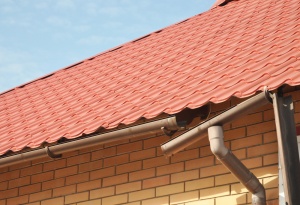Rain gutters are essential in order to keep your home secure and undamaged. By channeling excess water away from the foundations, they prevent flooding, deter moisture buildup in the walls and lower levels of your home (which also discourages pests and mold growth), and even prevent major problems like a cracked foundation.
It’s important to be proactive in maintaining your rain gutters. Doing so will prevent more difficult and costly repairs in the future.
Common Problems with Rain Gutters
-
Leaks within gutter: This is probably the most common problem with a rain gutter, but few of us identify leaks until they become large. After all, in rainy weather it’s difficult to identify these leaks. There’s rain going everywhere, and the wind can lead to splashing and errant moisture that might look like a leak at first. You can identify gutter leaks by waiting for a clear day, and sticking your garden hose in the drain. Then you can look around and identify leaky spots. For small leaks, especially in areas where the gutter has joins or edging, you can stop the leak by caulking. However, you’ll need a pro if the damage is more extensive.
-
Disconnection from fascia: When the gutter pulls away from the home’s fascia, water will go between the roof and gutter, straight into the foundation of your home. Most of the time you can double-check the hangers attaching the gutter to the fascia of the home. Reinforce areas that don’t have enough hangers, re-fasten existing hangers, and tighten ones that look a little loose.
-
Sagging gutters: Sometimes, the weight from water in the gutters can cause them to sag down. Often, the outer side of your gutter can give out a little. You can prevent this by reinforcing the interior of the gutter with hangers. However, if you have sagging gutters, you might need to clean them out, or check the tilt to make sure that the water is draining properly.
-
Detached downspouts: Detached downspouts can be refastened much like disconnected rain gutters, with hangers. Sometimes, you can also have problems with downspouts causing too much erosion in one part of your yard. You can reduce the amount of erosion that one area it taking by installing downspout extenders.
-
Improper pitch: Improper pitch refers to the tilt of your rain gutters. Ideally, they’ll gradually slope to the downspout, allowing water to easily flow out. However, often rain gutters don’t drain properly because the pitch is off, and gravity can’t get it where it needs to go. In order to check this, look in your gutters after rain. Standing water in the gutter is a problem. It will lead to more clogs, more breeding grounds for mosquitoes, and more weight and strain on the gutters and fasteners.
Call Us for Repair and Installation
Many repairs are pretty simple to do yourself, but bigger issues will require a pro’s help. If that’s the case for you, don’t hesitate to give us a call! We’ve had years of experience installing and repairing rain gutters in Salt Lake and Utah County, and we know how to get it done right the first time in order to protect your home for years to come.




